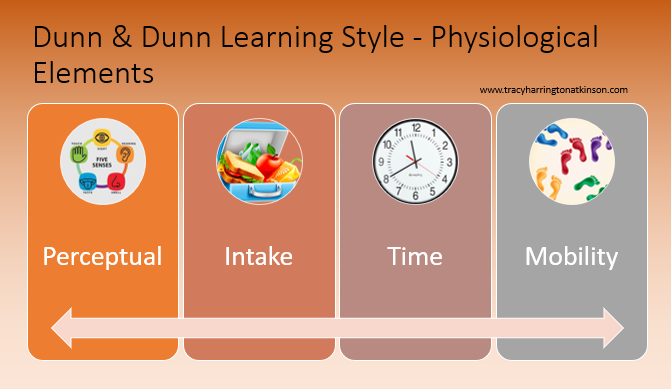
Physiological concerns how the student physically engages their learning environment. What are their perceptual preferences (visual, audio, kinesthetic, read/write)? What time of the day are they most effective as learners? Do they need to be moving to learn? Hands-on learner? Or maybe they are a passive learner who simply prefers to observe.
The elements related to physiology include:
- Perceptual
- Intake
- Time
- Mobility

Personalized Learning Inventory – Unlock Your Learning Potential: Discover Your Unique Style with the Dunn & Dunn Personalized Learning Assessment is a comprehensive guide that helps readers identify their individual learning preferences using the Dunn & Dunn model. This book provides an insightful assessment that allows learners to better understand their unique learning styles, focusing on key areas such as environmental, emotional, sociological, physiological, and psychological factors.
Perceptual
Perceptual is how individuals take in information through their five senses. Does the student prefer to learn visually, read or through audio means? Do they need a tactile approach? Or maybe the learner requires a combination of these approaches. However, each of the senses contributes to the amount of knowledge that will be retained. Choosing the optimal venue will increase the retention.
Think of the VARK learning methodology. This is an easy way to reach these varying learning senses.
The best option for approaching the perceptual domain is to teach through a means that will combine the visual, auditory, reading/writing and kinesthetic modalities.
Intake
Intake aligns with the lowest rung of Maslow’s Hierarchy of Needs – The Physiological Needs. Or simply put – food. In the most basic of understanding for intake, the student needs to be well-nourished. A student that is hungry will be more focused on hunger than on new information.
Interestingly, for Dunn & Dunn, intake is not just for nutritional value. Ponder for a moment the student who is constantly grazing on snacks while studying, while others never snack. Maybe a student needs a cup of water nearby or to chew on a piece of gum. Not only does food replace expended energy, but it also aids in relaxing tensions and anxiety that some students may experience while concentrating.
Time
Think about the time of day that you study and learn best. Some individuals will prefer to be a night owl. They will be up all night and thrilled to study while others may prefer the early morning. There are also times when concentration dips low. What times of the day are you more effective at learning and less effective at learning?
In teaching, the most effective way to reach all students during their most optimal learning times is to use an asynchronized approach which is most accessible during these times of abundant technology options.
Mobility
Mobility is the need for movement while learning. Some students are going to be perfectly still while others may be constantly moving.
This is an easy part of the learning personality to identify. It is simply a matter of observation. Does the student seem to be constantly moving? Are they still? Do they fidget? Do they seem to be constantly touching and moving items around? The answers to these questions will aid in determining the mobility needs of the student.
Sadly for students, this is an area where they will tend to have the least amount of control.
An interesting correlation between mobility and learning settings exists. The more mobility the student requires the more informal setting they will need and vice versa.
Sources:
Dunn, R. & Dunn, K. (1978). Teaching Students Through Their Individual Learning Styles: A Practical Approach. Allyn and Bacon.
McLoed, S. (2020).Maslow’s Hierarchy of Needs. Retrieved from https://www.simplypsychology.org/maslow.html#gsc.tab=0
Subscribe to our YouTube Channel by clicking here.
By Tracy Atkinson

Comments are closed